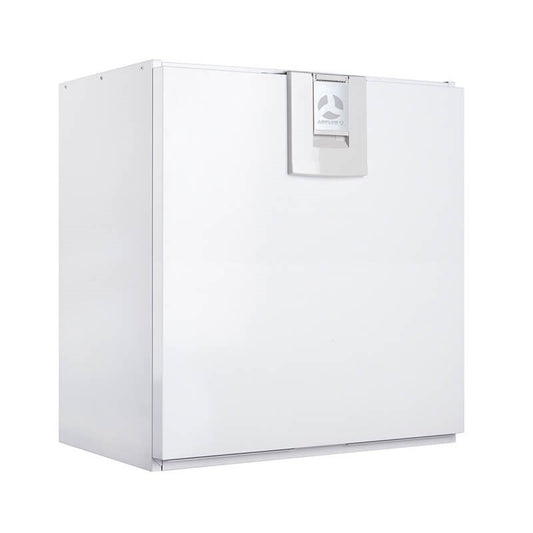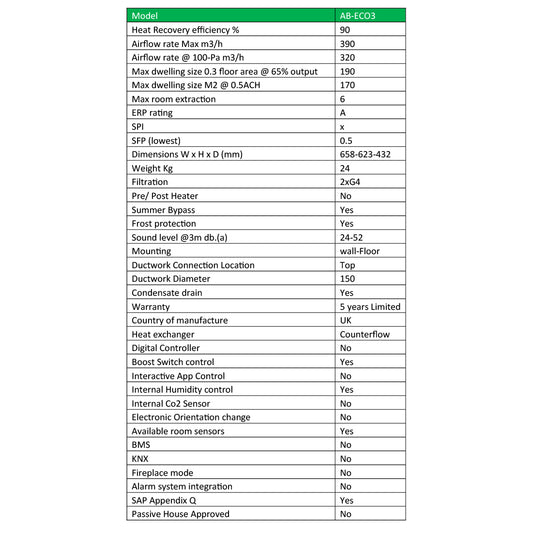Collection: Heat Recovery Units
-
BSK Zephyr Single Room Heat Recovery Unit
Vendor:BSKRegular price £182.25 GBPRegular priceUnit price / per£225.00 GBPSale price £182.25 GBPSaleIN STOCK -
Vent Axia Sentinel Kinetic BH Unit (RH) - 443319
Vendor:Vent AxiaRegular price £844.20 GBPRegular priceUnit price / per£1,260.00 GBPSale price £844.20 GBPSaleIN STOCK -

 Sale
SaleVent Axia Integra
Vendor:Vent AxiaRegular price £776.64 GBPRegular priceUnit price / per£1,159.16 GBPSale price £776.64 GBPSaleIN STOCK -
BSK NOTUS Multi Orientation Unit with Humidity Sensor
Vendor:BSKRegular price £734.92 GBPRegular priceUnit price / per£1,096.90 GBPSale price £734.92 GBPSaleIN STOCK -

 Sold out
Sold outNuaire - AB-WM1 MRXBOX95 Unit
Vendor:NuaireRegular price £774.71 GBPRegular priceUnit price / per£1,156.28 GBPSale price £774.71 GBPNuaire - AB-WM1 MRXBOX95 Unit
Regular price £774.71 GBPRegular priceUnit price / per£1,156.28 GBPSale price £774.71 GBPNuaire - AB-WM1 MRXBOX95 Unit
Regular price £774.71 GBPRegular priceUnit price / per£1,156.28 GBPSale price £774.71 GBPSold out -
Vent Axia Sentinel Kinetic Plus B Heat Recovery (RH) Unit - 443028
Vendor:Vent AxiaRegular price £1,159.10 GBPRegular priceUnit price / per£1,730.00 GBPSale price £1,159.10 GBPSaleIN STOCK -
 Sale
SaleVent Axia HR100R/RS
Vendor:Vent AxiaRegular price From £291.98 GBPRegular priceUnit price / per£435.79 GBPSale price From £291.98 GBPVent Axia HR100R/RS
Regular price From £291.98 GBPRegular priceUnit price / per£435.79 GBPSale price From £291.98 GBPVent Axia HR100R/RS
Regular price From £291.98 GBPRegular priceUnit price / per£435.79 GBPSale price From £291.98 GBPSaleIN STOCK -
Vent Axia Sentinel Kinetic BH Unit (LH) - 443319L
Vendor:Vent AxiaRegular price £844.20 GBPRegular priceUnit price / per£1,260.00 GBPSale price £844.20 GBPSaleIN STOCK -
Nuaire MRXBOXAB-ECO2 Heat Recovery System
Vendor:NuaireRegular price £896.13 GBPRegular priceUnit price / per£1,337.50 GBPSale price £896.13 GBPNuaire MRXBOXAB-ECO2 Heat Recovery System
Regular price £896.13 GBPRegular priceUnit price / per£1,337.50 GBPSale price £896.13 GBPNuaire MRXBOXAB-ECO2 Heat Recovery System
Regular price £896.13 GBPRegular priceUnit price / per£1,337.50 GBPSale price £896.13 GBPSaleIN STOCK -
Vent Axia Sentinel Kinetic Highflow Heat Recovery (RH) Unit - 408449
Vendor:Vent AxiaRegular price £1,541.00 GBPRegular priceUnit price / per£2,300.00 GBPSale price £1,541.00 GBPSaleIN STOCK -

 Sale
SaleDomus HRXE-AURA-H-B
Vendor:DomusRegular price From £1,033.37 GBPRegular priceUnit price / per£1,542.34 GBPSale price From £1,033.37 GBPDomus HRXE-AURA-H-B
Regular price From £1,033.37 GBPRegular priceUnit price / per£1,542.34 GBPSale price From £1,033.37 GBPDomus HRXE-AURA-H-B
Regular price From £1,033.37 GBPRegular priceUnit price / per£1,542.34 GBPSale price From £1,033.37 GBPSaleIN STOCK -
Vent Axia Sentinel Kinetic FH Heat Recovery (RH) Unit - 408167
Vendor:Vent AxiaRegular price £1,025.10 GBPRegular priceUnit price / per£1,530.00 GBPSale price £1,025.10 GBPSaleIN STOCK -
Nuaire MRXBOXAB-ECO5B Heat Recovery Unit
Vendor:NuaireRegular price £1,421.61 GBPRegular priceUnit price / per£2,121.81 GBPSale price £1,421.61 GBPNuaire MRXBOXAB-ECO5B Heat Recovery Unit
Regular price £1,421.61 GBPRegular priceUnit price / per£2,121.81 GBPSale price £1,421.61 GBPNuaire MRXBOXAB-ECO5B Heat Recovery Unit
Regular price £1,421.61 GBPRegular priceUnit price / per£2,121.81 GBPSale price £1,421.61 GBPSaleIN STOCK -
Nuaire MRXBOXAB-ECO3B Heat Recovery Unit
Vendor:NuaireRegular price £1,039.51 GBPRegular priceUnit price / per£1,551.50 GBPSale price £1,039.51 GBPNuaire MRXBOXAB-ECO3B Heat Recovery Unit
Regular price £1,039.51 GBPRegular priceUnit price / per£1,551.50 GBPSale price £1,039.51 GBPNuaire MRXBOXAB-ECO3B Heat Recovery Unit
Regular price £1,039.51 GBPRegular priceUnit price / per£1,551.50 GBPSale price £1,039.51 GBPSaleIN STOCK -
Zehnder ComfoAir Q 350 Heat Recovery Unit
Vendor:ZehnderRegular price From £2,165.98 GBPRegular priceUnit price / per£3,232.80 GBPSale price From £2,165.98 GBPZehnder ComfoAir Q 350 Heat Recovery Unit
Regular price From £2,165.98 GBPRegular priceUnit price / per£3,232.80 GBPSale price From £2,165.98 GBPZehnder ComfoAir Q 350 Heat Recovery Unit
Regular price From £2,165.98 GBPRegular priceUnit price / per£3,232.80 GBPSale price From £2,165.98 GBPSaleIN STOCK -
Vent-Axia Sentinel Econiq S - 499883
Vendor:Vent AxiaRegular price £1,327.94 GBPRegular priceUnit price / per£1,982.00 GBPSale price £1,327.94 GBPSaleIN STOCK -
Vent Axia Sentinel Kinetic Plus B Heat Recovery (LH) Unit - 443028L
Vendor:Vent AxiaRegular price £1,159.10 GBPRegular priceUnit price / per£1,730.00 GBPSale price £1,159.10 GBPSaleIN STOCK -
Nuaire MRXBOXAB-ECO4 Heat Recovery System
Vendor:NuaireRegular price £1,916.79 GBPRegular priceUnit price / per£2,860.88 GBPSale price £1,916.79 GBPNuaire MRXBOXAB-ECO4 Heat Recovery System
Regular price £1,916.79 GBPRegular priceUnit price / per£2,860.88 GBPSale price £1,916.79 GBPNuaire MRXBOXAB-ECO4 Heat Recovery System
Regular price £1,916.79 GBPRegular priceUnit price / per£2,860.88 GBPSale price £1,916.79 GBPSaleIN STOCK -
Domus HRX-E HERA Heat Recovery Unit
Vendor:DomusRegular price £886.83 GBPSale price £886.83 GBPUnit price / perDomus HRX-E HERA Heat Recovery Unit
Regular price £886.83 GBPSale price £886.83 GBPUnit price / perDomus HRX-E HERA Heat Recovery Unit
Regular price £886.83 GBPSale price £886.83 GBPUnit price / perSaleIN STOCK -
Vent Axia Sentinel Kinetic Highflow Heat Recovery (LH) Unit - 408451
Vendor:Vent AxiaRegular price £1,541.00 GBPRegular priceUnit price / per£2,300.00 GBPSale price £1,541.00 GBPSaleIN STOCK -
Vent Axia Integra Plus EC
Vendor:Vent AxiaRegular price £987.58 GBPRegular priceUnit price / per£1,474.00 GBPSale price £987.58 GBPSaleIN STOCK -
QV- Himpel 250 EPP unit with controller, bypass and Hepa Filter - 250m3/h @ 100Pa
Vendor:Quiet-VentRegular price £534.73 GBPRegular priceUnit price / per£798.10 GBPSale price £534.73 GBPSold out -
Vent-Axia Sentinel Econiq L - 499641
Vendor:Vent AxiaRegular price £2,213.68 GBPRegular priceUnit price / per£3,304.00 GBPSale price £2,213.68 GBPSaleIN STOCK -
Nuaire AB-ECO-LP2 Ceiling Void Horizontal MVHR Unit
Vendor:NuaireRegular price £1,349.74 GBPRegular priceUnit price / per£2,014.53 GBPSale price £1,349.74 GBPNuaire AB-ECO-LP2 Ceiling Void Horizontal MVHR Unit
Regular price £1,349.74 GBPRegular priceUnit price / per£2,014.53 GBPSale price £1,349.74 GBPNuaire AB-ECO-LP2 Ceiling Void Horizontal MVHR Unit
Regular price £1,349.74 GBPRegular priceUnit price / per£2,014.53 GBPSale price £1,349.74 GBPSaleIN STOCK -
Vent-Axia Sentinel Econiq M - 499632
Vendor:Vent AxiaRegular price £1,878.68 GBPRegular priceUnit price / per£2,804.00 GBPSale price £1,878.68 GBPSaleIN STOCK -

 Sale
SaleAirflow Adroit DV96
Vendor:AirflowRegular price From £2,475.08 GBPRegular priceUnit price / per£3,694.15 GBPSale price From £2,475.08 GBPAirflow Adroit DV96
Regular price From £2,475.08 GBPRegular priceUnit price / per£3,694.15 GBPSale price From £2,475.08 GBPAirflow Adroit DV96
Regular price From £2,475.08 GBPRegular priceUnit price / per£3,694.15 GBPSale price From £2,475.08 GBPSaleIN STOCK -
Airflow DV130 Entro MVHR Unit
Vendor:AirflowRegular price From £1,336.21 GBPRegular priceUnit price / per£2,792.09 GBPSale price From £1,336.21 GBPAirflow DV130 Entro MVHR Unit
Regular price From £1,336.21 GBPRegular priceUnit price / per£2,792.09 GBPSale price From £1,336.21 GBPAirflow DV130 Entro MVHR Unit
Regular price From £1,336.21 GBPRegular priceUnit price / per£2,792.09 GBPSale price From £1,336.21 GBPSaleIN STOCK -
Vent Axia Sentinel Kinetic FH Heat Recovery (LH) Unit - 408169
Vendor:Vent AxiaRegular price £1,025.10 GBPRegular priceUnit price / per£1,530.00 GBPSale price £1,025.10 GBPSaleIN STOCK -
DucoBox D350 Energy Comfort Plus
Vendor:DucoRegular price £1,800.61 GBPRegular priceUnit price / per£2,636.54 GBPSale price £1,800.61 GBPSaleIN STOCK -
Zehnder ComfoAir 155 WMe
Vendor:ZehnderRegular price £1,100.15 GBPRegular priceUnit price / per£1,642.02 GBPSale price £1,100.15 GBPSaleIN STOCK -
Zehnder ComfoAir 155 WM
Vendor:ZehnderRegular price £1,169.53 GBPRegular priceUnit price / per£1,745.56 GBPSale price £1,169.53 GBPSaleIN STOCK -
Airflow DV65 Entro MVHR Unit
Vendor:AirflowRegular price From £1,063.45 GBPRegular priceUnit price / per£2,222.14 GBPSale price From £1,063.45 GBPAirflow DV65 Entro MVHR Unit
Regular price From £1,063.45 GBPRegular priceUnit price / per£2,222.14 GBPSale price From £1,063.45 GBPAirflow DV65 Entro MVHR Unit
Regular price From £1,063.45 GBPRegular priceUnit price / per£2,222.14 GBPSale price From £1,063.45 GBPSaleIN STOCK -
Zehnder ComfoAir Q 450 Heat Recovery Unit
Vendor:ZehnderRegular price From £2,574.98 GBPRegular priceUnit price / per£3,843.26 GBPSale price From £2,574.98 GBPZehnder ComfoAir Q 450 Heat Recovery Unit
Regular price From £2,574.98 GBPRegular priceUnit price / per£3,843.26 GBPSale price From £2,574.98 GBPZehnder ComfoAir Q 450 Heat Recovery Unit
Regular price From £2,574.98 GBPRegular priceUnit price / per£3,843.26 GBPSale price From £2,574.98 GBPSaleIN STOCK -
Domus AQH200-B Horizontal 204-60 MVHR Unit
Vendor:DomusRegular price £1,010.45 GBPRegular priceUnit price / per£1,508.13 GBPSale price £1,010.45 GBPSaleIN STOCK -
Vent Axia Lo-Carbon Sentinel Kinetic Cooker Hood (LH)
Vendor:Vent AxiaRegular price £1,700.88 GBPRegular priceUnit price / per£2,538.62 GBPSale price £1,700.88 GBPSaleIN STOCK -
Vortice HR 350 Avel Heat Recovery Unit
Vendor:VorticeRegular price £3,172.25 GBPRegular priceUnit price / per£4,734.70 GBPSale price £3,172.25 GBPSaleIN STOCK
Heat Recovery Units
Heat Recovery Ventilation is a system which comprises a Heat Recovery Unit and a network of ducting which is connected to each room from a single unit, located ideally in the heated building envelope. This works by continuously extracting air from the wet rooms of the property and at the same time drawing in fresh supply air from outside.
The heat from the extracted, stale air is recovered via a heat exchanger inside the heat recovery unit which is then reused to temper the filtered supply air for the habitable rooms such as living rooms and bedrooms. Up to 95% of the heat can be recovered. The Heat Recovery Unit runs continuously on trickle and is boosted when higher rates of ventilation are required e.g. bathing, cooking. In warmer months a summer by-pass function helps ensure comfort levels are maintained in the home. When summer by-pass is activated, the dwelling continues to be ventilated and receive fresh filtered air. However, the heat recovery process is intermittently switched off (heat recovery is by-passed).
Heat Recovery Ventilation and its application in new homes has significantly grown over the last few years as the focus and improvements in airtightness are increased through Building Regulations e.g. ADL: Conservation of Fuel and Power.
With 100% of ventilation needing to be provided through purposely installed systems, heat recovery offers major benefits to the building and occupants.
Key Benefits;
- Year round removal of condensation and indoor pollutants.
- A direct impact on the Dwelling Emission Rate required in SAP, helping reduce the carbon footprint of the property.
- Fresh filtered air supplied to dwelling, ideal for allergy sufferers and those with conditions such as asthma.
- A balanced ventilation system for the whole house and recovering of heat that would have otherwise have been lost.
- Low noise, non-intrusive ventilation system – located away from the room, however consideration should be given to duct runs to ensure cross-talk contamination doesn’t happen AND the unit is sized correctly so it is not running a high rate all of the time.
Choosing or specifying a Heat recovery system is more than simply choosing the best SFP (Specific Fan Power Performance) and Heat Efficiency (e.g. 93%)
Consideration must be given to application in order that Guaranteed Installed Performance can be achieved effectively onsite. Following these three rules will ensure you choose the correct SIZE. - and it all starts with the 1) DESIGN.
2)Heat recovery unit for your dwelling. An incorrectly sized unit will introduce noise to a property as it will have to work harder to deliver the Building Regulations requirements.
3) Size the unit based on Dwelling Design. Sizing the unit depends on total system pressure. A system may easily provide the correct airflow at 0 pascals, however adding ducting causes resistance and this will reduce airflow Use the pressure curve provided with the product to determine whether it can perform in the location it is intended for Best Practice Guidelines not that a heat recovery unit should not run at above 60% of airflow capacity on trickle speed.
















































































